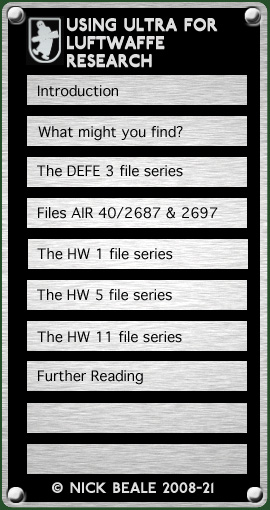As far as I know, Andrew Arthy and Morten Jessen were the first to exploit these files for a Luftwaffe publication, Focke-Wulf Fw 190 in North Africa, and it was reading their source notes that first alerted me to this material. I’d long thought there had to have been something of the kind because the DEFE 3 messages are full of indications that Bletchley Park knew more than they were saying. Finding that the “unabridged versions” had survived the war was very welcome. And when I got to look at the files, I had the explanation for those mysterious “CX/MSS/…” references at the top of the Ultra messages I’d been reading for the previous 15 years. The file series The material in HW 5 comes much closer than DEFE 3 does to a straight translation of the original German message. This makes it both more rewarding and more frustrating than DEFE 3. The difference is best illustrated by an example of how the same message appears in the two series: DEFE 3/157, report KV 4337 TAKING OVER OF ONE ME 109 H, REPEAT H, FROM GUYANCOURT REPORTED ON 16TH [MAY 1944] BY (STRONG INDICATIONS 5./(F)/123). COMMENT AGREED WITH D.D.I. 2: NO DEFINITE INFORMATION ABOUT ME 109 H BUT PROBABLY FOR HIGH ALTITUDE PR. HW 5/484, teleprint CX/MSS/T187/48 WEST EUROPE TO TECHNICAL OFFICER, DATED 16/5:- THE STAFFEL REPORTS SURRENDER OF BF 109 G-5, WORKS NO 1(B%1)0346, THROUGH SALVAGE DETACHMENT 20/IV ANVIEN(+) TO GUYANCOURT WORKSHOP ON 14/5. THE STAFFEL REPORTS ACCEPTANCE OF BF 109 H, WORKS NO. 110073 ON 16/5, FROM GUYANCOURT WORKSHOP. A/C HAS DB605-GS ENGINE MMM METHANOL INSTALLATION AND GM1- INSTALLATION, CAMERA 50/30, FU GE 16 Z, WITH HOMING ATTACHMENT ZVG 16, FA16E AND FA16S, PRESSURE CABIN, AND 1 MG 151-20. NOTES: 1) SOURCE BELIEVES ABOVE FROM 5(F)123 2) (+) NOT LOCATED. MAY BE ANVIN, LOCATED IN PAS DE CALAIS AREA 3) AN ME 109 WITH H BUILT IN £H - EINBAU£ WAS READY TO BE COLLECTED FROM GUYANCOURT ON 10/5 (T182/3) 4) SEE T187/47 FOR TECHNICAL DEFECTS IN THE COMPRESSED AIR SUPPLY OF BF 109 G-5 (HIGH ALTITUDE A/C). 1752/17/5/44 The files These are available in hard copy, as bound volumes in foolscap format (8.5 x 13.5 in = 21.6 x 34.3 cm). In 1944, except for a spell in the summer where each file covers just one day, almost all contain two days’ decrypts. Unlike DEFE 3, the file numbering corresponds with the calendar, beginning with HW 5/1 (6 February–16 July 1940) and ending with HW 5/703 (7–23 May 1945). In fact the series goes on to HW 5/767 but those later files appear to contain other sorts of material. By 1944, each file begins with a few pages listing the frequency band and radio net (given an Allied codename) from which each message was picked up. The day’s decrypted material is then divided into reports and teleprints. Reports are pages of decrypted items, mostly fairly short, each one shown as a numbered paragraph. There are five sections: A (General), B (South Europe), C (West Europe), D (East Europe) and — for a time — E (South East Europe) and each of these is divided into Air, Military, Naval and Inter-service. Inter-service messages can be useful, for instance when the army reports a downed aircraft or pilot. After that come the day’s teleprints. In format these are much more like the messages in DEFE3 but usually with more specific information — they give people’s names, aircraft Werk Nummern and so on whereas DEFE 3 will just say “an officer” or “three Ju 52s.” In the second half of 1944, section A of the reports gains an extra paragraph: a table (which can run to three pages) of aircraft and engines mentioned in deciphered traffic. The column headings are as follows but often there’s nothing more than a “–” under some of them:
Because the binding is always on the left hand side of the pages with text, the date is often lost to view. Occasionally there is enough information to be valuable in itself but in most cases it’s probably most useful to supplement other material you have (e.g. for anyone dedicated enough to keep a Werk Nummer database). Sometimes it’s clear which report or teleprint the data is taken from but not always. This suggests that there may have been German signals that were little more than a list of numbers. In files covering two days, the report/teleprints sequence is then repeated for the second day’s decrypts. Reference number Every reference from 14 November 1943 onward is in the CX/MSS series. Earlier series were CX/FJ and CX/JQ but I’ve only done a limited amount of work on those. After CX/MSS/ comes either “R” (for Report) or “T” (for Teleprint). Then comes a number denoting the day the message was decrypted: 14 November 1943 was day 1; 15 November 1943 was day 2 and so on. So CX/MSS/R206 (C) would be the “West” section of the report for day 206 (which happens to be 6 June 1944). When cross-referencing to an earlier message the individual paragraph number will sometimes be tagged on the end as well. CX/MSS/T415/24 is teleprint number 24 for 1 January 1945. Apparently CX was the Secret Intelligence Service (M.I.6) prefix for an agent's report and was used to disguise the true source of the intelligence. MSS is said by some writers to have meant "Most Secret Source." continued on next page …
|
||||||||


